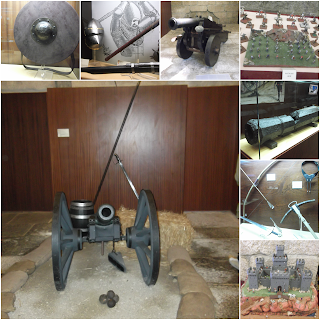So Like I said I'm back :)
Due to the fact that around this time there's a lot of small festivities in some villages around my region, I decided to talk about one that stands up above the others because of its military purpose once... Almeida - a small village near to the border with Spain.
I confess that I was there for a few times with my parents, but I went back in 2015 for a flash trip with Erasmus students, and it's a whole different experience... I could finally check out some "secret passages" and play with some "characters" :)
 Almeida is a Portuguese village belonging to Guada's County, with about 1300 inhabitants. The village is known for its fortress, a twelve-pointed star, so one of the most spectacular European defensive systems (army lovers this is a place to visit)!
Almeida is a Portuguese village belonging to Guada's County, with about 1300 inhabitants. The village is known for its fortress, a twelve-pointed star, so one of the most spectacular European defensive systems (army lovers this is a place to visit)!
"Almeida [...] committed to [...] building a renewed war machine that could adapt to new fire arms and allow seal the border." - www.aldeiashistoricasdeportugal.com. This village is part of the historic villages of Portugal and some of the information (that I no longer remember) was through the site above (give it a look).
According to historical sources had its origin thanks to the migration of the inhabitants of a Lusitanian busy 61 B.C. by the Romans and later by barbarians. Given its geographical location (plateau), the Arabs named it Al-Mêda, Talmeyda or Almeydan, having been built a castle in the VII-IX centuries.
In the period of the Reconquest, Christians took Almeida in 1190 and was later disputed with León (Spain), moving to Lusitanian possession in 1297 through the Treaty of Alcañices.
Received royal charter by D. Dinis (1296), who built the castle and again with D. Manuel (1510). The french invasions devasted much of the village. During the Seven Years War (1756-1763), Almeida went back to Spain and was taken up in 1763. along the liberal fights between 1829 and 1832 its walls were destroyed, only rebuilt in 1853 (so many wars!!!). In 1927 came the las Cavalry Squadron losing the military activity that for centuries was the reasons for its existence.
 Are a strong attraction the Square (century XVII/XVIII), a baroque military architectural model, a fortress with hexagonal layout. The access is made through the double doors in arched tunnel - Santo António and Saint Francis of the Cross. It has six bastions with its casemates - underground galleries where the population gathered in case of danger and also served as prisons during civil war - and ravelins with moats 12 meters deep, where was built a field hospital and is currently located the Military Museum (for those that like to know more about fire arms and military stuff its a cool museum and not very expensive).
Are a strong attraction the Square (century XVII/XVIII), a baroque military architectural model, a fortress with hexagonal layout. The access is made through the double doors in arched tunnel - Santo António and Saint Francis of the Cross. It has six bastions with its casemates - underground galleries where the population gathered in case of danger and also served as prisons during civil war - and ravelins with moats 12 meters deep, where was built a field hospital and is currently located the Military Museum (for those that like to know more about fire arms and military stuff its a cool museum and not very expensive). |
| two Portuguese girls and two Brazilian guys :) |
 I can actually tell you that visiting the museum it was fun!! My group and I had a blast creating scenes with the characters... and guess what... in several rooms are this touchscreens with info about the artifacts, but we actually found one were we took a picture... it was a blast (crazy people)!!! And after we played a little we found some passages that took us outside the walls :o!!!
I can actually tell you that visiting the museum it was fun!! My group and I had a blast creating scenes with the characters... and guess what... in several rooms are this touchscreens with info about the artifacts, but we actually found one were we took a picture... it was a blast (crazy people)!!! And after we played a little we found some passages that took us outside the walls :o!!! |
| Us and our secret passage!! |
 |
| It was dark!!! |




Sem comentários:
Enviar um comentário